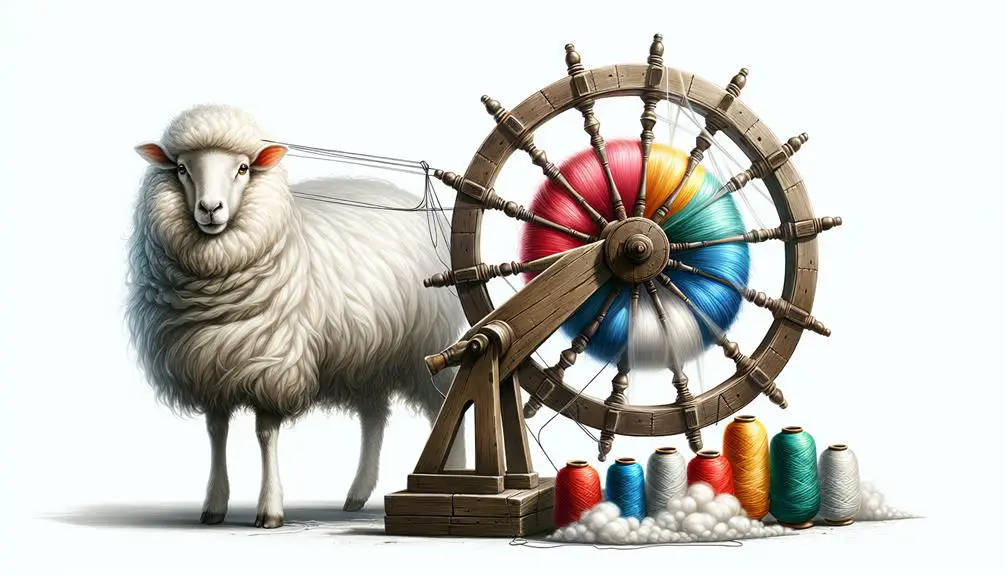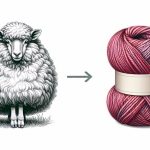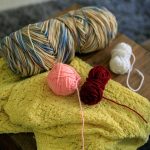I call wool yarn because it can be spun into fibers for crafts like knitting and weaving. Its threads twist together to make yarn. If you're curious, there's more about the process and significance of wool yarn waiting to be discovered.
Table of Contents
Key Takeaways
- Wool is called yarn because it is spun wool fibers twisted into a continuous strand for knitting, crocheting, or weaving.
- Yarn refers to any continuous strand used for textiles, with wool yarn specifically made from animal fibers like sheep.
- Wool yarn is known for its softness, warmth, and durability, making it a popular choice for various crafting projects.
- The process of spinning wool aligns fibers to create a strong thread, essential for making wool yarn.
- Wool yarn's natural properties like elasticity, insulation, and moisture-wicking qualities make it a sought-after material for textiles.
Definition of Yarn Vs. Wool
When diving into the world of textiles, understanding the distinction between yarn and wool is essential for any crafting enthusiast. Yarn is a versatile material made of fibers, while wool specifically comes from animals like sheep, goats, rabbits, and lambs. The spinning process is vital in converting animal fibers into yarn suitable for various crafts like knitting and crocheting.
In essence, wool serves as the raw material derived from animals, whereas yarn consists of twisted strands of fibers used in textile projects. While yarn can encompass a range of fibers like cotton, silk, and acrylic, wool remains unique in its origin from animal sources.
Recognizing the differences between wool and yarn not only sheds light on their individual characteristics but also aids in selecting the right materials for specific crafting endeavors, whether it involves weaving, knitting, or other textile arts. Mastering the distinction between these two components is fundamental for anyone looking to explore further into the world of textiles.
Historical Origins of Yarn
Yarn's historical origins trace back to ancient civilizations such as the Stone Age. Back then, people crafted yarn using various natural fibers, including wool. As civilizations advanced, so did the techniques for making yarn. Initially, yarn was made from animal hides, but over time, fibers like cotton, wool, and silk became more popular choices. The development of yarn played a pivotal role in the ancient textile trade, shaping early economies globally.
Natural fibers, like wool, played a significant role in the evolution of yarn. These fibers, sourced from plants or animals, were spun into yarn for weaving textiles. Wool, specifically, was valued for its warmth, softness, and versatility in creating durable fabrics. Other natural fibers used for yarn include cotton, silk, linen, bamboo, and hemp. Understanding the historical significance of these natural fibers provides insight into the enduring legacy of yarn-making techniques throughout human history.
Spinning Wool Into Yarn
When spinning wool into yarn, the fibers are carefully twisted together to create a strong and versatile thread for crafting. This process aligns the raw wool fibers, turning them into a continuous strand ready for knitting or weaving projects.
Spinning transforms the bulky raw wool into a smooth, workable yarn that retains the natural qualities of warmth and durability.
Wool Yarn Creation
After wool fibers are aligned, twisted, and spun into yarn, they become a versatile material for various crafting projects. Wool is used to create spun yarns, offering strength and durability ideal for knitting, crocheting, and weaving.
Through the spinning process, raw wool is transformed into yarn, retaining its natural warmth, softness, and breathability. This makes wool yarn a preferred choice for cold-weather garments. Moreover, spinning wool into yarn allows for customization in texture, thickness, and color, catering to different preferences and project requirements.
The spun yarns made from wool showcase the unique qualities of the fiber, making them a popular option for creating cozy and long-lasting textile pieces.
Yarn Spinning Process
Spinning wool into yarn involves twisting fibers together to create a cohesive thread, transforming raw wool into a versatile material for crafting projects. The yarn spinning process is vital for producing high-quality wool yarn. Whether done by hand or with industrial machinery, spinning fibers is what gives yarn its strength and texture.
By carefully controlling the spinning process, different types of wool yarn, like worsted or woolen, can be created, each with its own unique characteristics. Understanding the intricacies of yarn spinning is essential for mastering the art of working with wool fibers.
It's fascinating how such a simple process can result in the creation of beautiful and functional yarn for various knitting, crocheting, or weaving projects.
Wool to Yarn
To transform wool into yarn, fibers are twisted together to create a continuous thread, preserving the natural properties of warmth, softness, and durability inherent in wool. Wool comes from various animals like sheep, alpaca, or goats and undergoes a process called spinning to turn it into yarn. During this transformation, the fibers are aligned and twisted to form a cohesive strand ready for crafting. This process ensures that the unique qualities of wool are retained in the yarn, making it ideal for knitting, crocheting, or weaving projects. The term 'wool yarn' is commonly used to specify yarn made exclusively from wool fibers sourced from these animals.
| Wool to Yarn Process | Benefits of Wool Yarn | Animal Sources | Common Usage |
|---|---|---|---|
| Fibers twisted to form thread | Retains warmth, softness, durability | Sheep, alpaca, goats | Knitting, crocheting, weaving |
Characteristics of Wool Yarn
With its natural elasticity and insulating properties, wool yarn stands out as a versatile and cozy material for crafting projects. Wool yarn is derived from the natural protein fibers of animals like sheep, goats, and rabbits. These fibers have varying diameters, affecting the yarn's softness and durability. Additionally, wool yarn is often twisted in an S direction, enhancing its strength and resilience.
The fiber diameter of wool yarn can influence its texture, with finer fibers creating softer yarn suitable for delicate garments, while coarser fibers produce sturdier yarn for projects like rugs or outerwear. The natural crimp in wool fibers not only adds texture but also traps air, providing excellent insulation against cold weather. This moisture-wicking and breathable quality make wool yarn comfortable to wear in diverse climates.
Merino wool yarn, known for its fine fibers and softness, is a favored choice for projects requiring a gentle touch against the skin. Whether you're knitting, crocheting, or weaving, wool yarn offers a wide range of options to explore in your crafting endeavors.
Wool Yarn in Textile Crafts
When crafting textile projects, wool yarn adds a touch of warmth and natural charm to every stitch. Wool is one of the most beloved materials for making yarn due to its exceptional qualities. Yarn made from wool retains the natural warmth, softness, and durability that wool fibers are known for. Using wool yarn in your projects not only provides a cozy feel but also guarantees that your creations will endure the test of time.
I love working with wool yarn because of its versatility. Whether I'm knitting a cozy sweater, crocheting a soft blanket, or crafting intricate accessories, wool yarn always delivers excellent results. The different types of wool yarn, such as merino, lambswool, and alpaca, each bring their unique qualities to the table, allowing for endless possibilities in my creations.
Crafters often choose wool yarn for its natural feel, breathability, and ability to regulate temperature, making it a top choice for a wide range of projects. Whether you're a beginner or a seasoned crafter, wool yarn is a fantastic option to explore in your textile crafts.
Yarn Making Process
I find the yarn making process fascinating as it involves aligning and twisting fibers to create a cohesive thread for fabric production. Whether using natural or synthetic fibers, the art of making yarn plays an essential role in producing different kinds of clothes, each with its unique characteristics. Let's explore a bit deeper into how this process works:
| Yarn Making Process | Different Kinds of Clothes | Natural or Synthetic Fibers |
|---|---|---|
| Aligning fibers | Sweaters, scarves | Wool, cotton |
| Twisting fibers | Socks, hats | Silk, bamboo |
| Choosing spinning techniques | Dresses, shirts | Polyester, nylon |
| Selecting colors | Pants, skirts | Rayon, acrylic |
This table highlights the diverse outcomes that can be achieved through the yarn making process, showcasing the versatility and creativity that goes into creating fabrics for a wide range of clothing items.
Wool Yarn Vs. Other Fibers
So, let's chat about the differences between wool yarn and other fibers.
Wool yarn, renowned for its warmth and softness, is just one of the many fibers used in yarn-making.
Understanding how wool compares to other fibers like cotton, silk, and acrylic can help us choose the perfect material for our crafting projects.
Wool Vs. Other Fibers
Wool yarn stands out from other fibers for its exceptional warmth, softness, and durability. When used in crafting, wool yarn offers unique advantages over synthetic fibers. Its natural properties like moisture-wicking and insulation make it a popular choice among creators.
Unlike synthetic materials, wool yarn has a natural elasticity and resilience that enhances the quality of handmade projects. Additionally, wool yarn's ability to retain heat even when wet makes it a preferred option in colder regions. These qualities set wool yarn apart from other fibers, making it a versatile and reliable choice for various knitting, crocheting, and weaving endeavors.
Yarn Characteristics Comparison
Comparing wool yarn to other fibers reveals its unique characteristics that set it apart with regards to warmth, breathability, and eco-friendliness.
Wool yarn, especially Merino wool, stands out for its natural warmth and moisture-wicking properties, making it ideal for various climates. Unlike synthetic fibers, wool yarn has natural elasticity and resilience that help it retain shape and provide excellent insulation.
Additionally, wool yarn is biodegradable and renewable, making it an eco-friendly choice compared to synthetic yarns derived from petroleum-based sources.
When compared to common plant fibers, wool yarn offers superior thermal regulation and comfort due to its unique crimp structure that traps air. These qualities make wool yarn a preferred option for those seeking warmth, breathability, and sustainability in the yarns they choose.
Wool Yarn Uses
When exploring the practical applications of wool yarn compared to other fibers, its versatility and unique properties become evident. Wool yarn stands out due to its elasticity, which allows it to stretch and bounce back into shape, making it ideal for items that need to retain their form.
Unlike synthetic fibers, wool yarn has natural moisture-wicking properties, keeping you warm and dry in various conditions. Its production is also eco-friendly as wool is biodegradable, renewable, and sustainable, making it a responsible choice for environmentally-conscious crafters.
The softness, warmth, and durability of wool yarn make it a popular fiber for cold weather garments and accessories. To sum up, the natural attributes of wool yarn set it apart from other fibers regarding functionality and sustainability.
Significance of Wool in Yarn-making
In the art of yarn-making, the importance of wool lies in its unparalleled softness, warmth, and versatility for crafting projects. Wool fibers, sourced from sheep and other animals, are twisted together to form yarn, which is then utilized in various textile applications. The process of twisting these fibers enhances the strength and durability of the yarn, making it ideal for knitting, crocheting, and weaving.
Wool yarn is favored for its natural elasticity, breathability, and moisture-wicking properties, providing comfort and functionality in finished projects. Additionally, wool's capacity to maintain dye well guarantees vibrant and long-lasting colors in yarn creations. Its insulating properties make wool yarn suitable for a wide range of items, from cozy winter garments to lightweight summer accessories.
Frequently Asked Questions
Why Do Americans Call Wool Yarn?
I call wool yarn because in the US, we often use the word 'yarn' to describe the fibers used for knitting or crocheting, which includes wool. It's just a regional language thing!
Why Is It Called Yarn?
Yarn is the term for spun fibers used in knitting, crocheting, and weaving. It's called yarn because the process of twisting wool fibers creates a continuous strand suitable for crafting textiles. Wool becomes yarn for our creative projects.
Is It Called Wool or Yarn?
It's often called 'wool' or 'yarn,' depending on where you are. In the UK and similar places, 'wool' is used for all yarn types. Understanding these regional differences is key to clear communication in crafting.
Do British People Call Yarn Wool?
Yes, British people commonly refer to yarn as wool. It's a regional quirk where 'wool' is used for all types of yarn. This can lead to confusion for those not familiar with the terminology difference, so understanding helps.
- How Does Ring Spun Cotton Affect Garment Fit and Shape Retention? - August 13, 2024
- What Are the Challenges in Producing Ring Spun Cotton? - August 13, 2024
- Is Ring Spun Cotton Suitable for Plus-Size Clothing? - August 13, 2024







